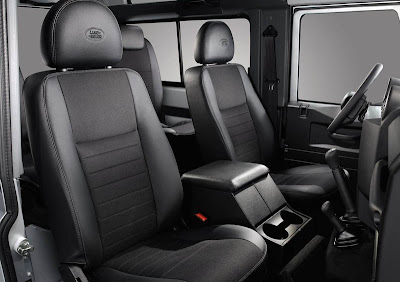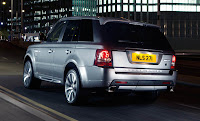Land Rover Range Rover Sport, 2010




The Land Rover Range Rover Sport reaffirms its status as the most exciting and dynamic member of the Land Rover range with a comprehensive package of engineering and design changes for the 2010 model year. The vehicle's stylish new appearance signals the transformation under the skin, which includes two powerful and efficient new engines - the LR-V8 naturally aspirated and
LR-V8 5.0-liter Supercharged, enhanced levels of interior craftsmanship and refinement, and significant improvements to both on-road and off-road driving dynamics.
A comprehensive program of chassis system modifications has transformed the Land Rover Range Rover Sport's on-road dynamics, while also delivering a substantial improvement in its off-road capabilities.
The introduction of new systems such as Adaptive Dynamics, working in conjunction with existing Dynamic Response on Supercharged models, and the addition of the road-focused Dynamic program to the Terrain ResponseTM system help enhance agility and ride quality. Further improvements to the Terrain ResponseTM system ensure that off-road capability is kept at the expected class-leading level.
The Land Rover Range Rover Sport's stylish, muscular exterior has been updated to provide a cleaner, more sculpted feel. Striking signature LED headlamps combine with a new two-bar grille, front bumpers and fenders to create a more sporting and aerodynamic stance. At the rear, new light clusters and a revised bumper design mirror the smoother front-end.
The interior has been comprehensively redesigned, using higher quality materials, soft-touch finishes and superior craftsmanship to create a premium environment which is truly worthy of the Range Rover brand.
New engines deliver exceptional performance and refinement.
The most significant changes on the 2010 Range Rover Sport are to its powertrains. The vehicle benefits from two powerful new engines: 510bhp LR-V8 5.0-liter supercharged and a 375bhp LR-V8 5.0 liter naturally aspirated engine.
The LR-V8 engines are all-new and designed by the Jaguar Land Rover powertrain team using an impressive collection of state-of-the-art technologies. They were developed with an emphasis on delivering a smooth, refined and responsive performance, without a corresponding increase in fuel consumption. Both meet the stringent ULEV2 emissions standards.
The performance of the all-new naturally aspirated LR-V8 is now a virtual-match for the outgoing 4.2L supercharged engine The new naturally aspirated vehicle completes the 0-60 mph sprint in 7.2 seconds (just 0.1 seconds off the pace of the outgoing supercharged unit). For those who want the ultimate performance Land Rover Range Rover Sport, there is now the all-new LR-V8 5.0L Supercharged, which is propelled from rest to 60 mph in an impressive 5.9 seconds.
The engines were developed in conjunction with Jaguar - the first time engines have been designed from the outset with the requirements of both brands in mind. Shared primary objectives included the highest possible torque and fast response from low revs.
Although the basic engine architecture is the same for each brand, Land Rover engine requirements differ to satisfy demanding all-terrain needs . For example, they feature a deeper sump to accommodate the extreme tilting angles that Land Rover Range Rover Sport may be subjected to off-road. In addition, belt drives are waterproofed, as are the alternator, air conditioning compressor, power steering pump and starter motor.
Direct injection - increased power and torque, low emissions.
One of the key features of the new LR-V8 is an industry first, centrally-mounted, multi-hole, spray-guided fuel injection system, delivering fuel at a pressure of up to 150bar (2175 psi) directly to the cylinder. The positioning of the injectors ensures fuel is precisely delivered to the center of the combustion chamber, maximizing air-fuel mixing, and improving combustion control.
Fuel is delivered by twin, high pressure fuel pumps driven via an auxiliary shaft in the all new engine block. Delivery of fuel direct to the cylinder has substantially contributed to improved low speed, dynamic response which is particularly useful off-road while adding to driving pleasure on-road. The charge cooling effects of the direct injection fuel system have allowed the compression ratio of the naturally aspirated engine to be raised to 11.5:1, further improving the engine economy.
During the engine warm-up phase, the combustion system employs multiple injection mode strategies to deliver 50 percent more heat for fast catalyst warm-up and reduced emissions.
New variable camshaft timing system boosts engine torque, saves energy.
A new type of variable camshaft timing system (VCT) introduces another industry first. The four VCT units are activated by the positive and negative torques generated by opening and closing the intake and exhaust valves, instead of by oil pressure. This has allowed the engine oil pump to be reduced in size, saving energy and reducing fuel consumption.
VCT units work independently on all four camshafts with 62 degrees of authority on the inlet cams and 50 degrees of authority on the exhaust cams. Timing is optimized by the engine control unit for torque, power and economy at every point in the engine's speed range.
The response rate of the new VCT units is 25 percent higher than before with actuation rates in excess of 150 degrees per second. This delivers a more immediate engine response to the driver's demand.
6th generation supercharger - quieter and more efficient.
A sixth generation, Eaton™ twin vortex system (TVS) supercharger is fitted to the 510 bhp engine. A compact Roots-type unit it feeds air through twin intercoolers which in turn are water-cooled by their own cooling circuit. The high helix rotor design both improves the supercharger thermodynamic efficiency by 16 percent. It also improves noise quality to the point where the unit is now almost inaudible. The intercoolers reduce the temperature of the pressurised intake-air and so optimize power.
The air intake has been radically redesigned compared to the previous V8. The intake air path is a direct feed to the supercharger inlet from the centrally mounted front throttle body. Air is delivered through twin air boxes which reduce flow loss and further increase efficiency. Mechanically, the new supercharger and its intercoolers are efficiently packaged in the V of the engine to deliver a low overall engine height.














